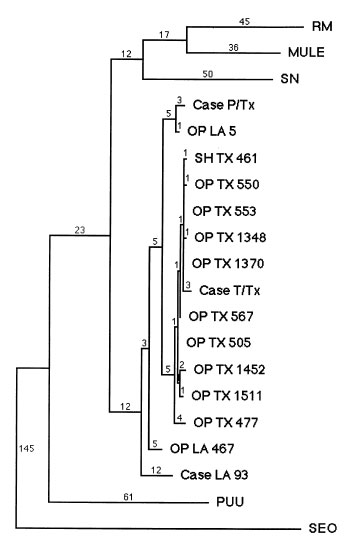Volume 4, Number 1—March 1998
Dispatch
Bayou Virus-Associated Hantavirus Pulmonary Syndrome in Eastern Texas: Identification of the Rice Rat, Oryzomys palustris, as Reservoir Host
Figure 4

Figure 4. Unweighted maximum parsimony tree produced by PAUP 3.1 software comparing a 397 nt portion of the hantavirus S genomic segments (residues 207 to 603) of patients and rodents infected with Bayou virus. A selection of other prototypical hantavirus sequences, each of which was compared antigenically in Figure 2, was included for comparison. Other hantaviruses are abbreviated as follows: RM=Rio Mamoré; MULE=Muleshoe; SN= Sin Nombre; PUU=Puumala; and SEO=Seoul. Human-derived Bayou virus sequences are indicated by Case, and rodent sequences by OP (Oryzomys palustris) or SH (Sigmodon hispidus). TX=Texas, LA=Louisiana.
Page created: December 14, 2010
Page updated: December 14, 2010
Page reviewed: December 14, 2010
The conclusions, findings, and opinions expressed by authors contributing to this journal do not necessarily reflect the official position of the U.S. Department of Health and Human Services, the Public Health Service, the Centers for Disease Control and Prevention, or the authors' affiliated institutions. Use of trade names is for identification only and does not imply endorsement by any of the groups named above.